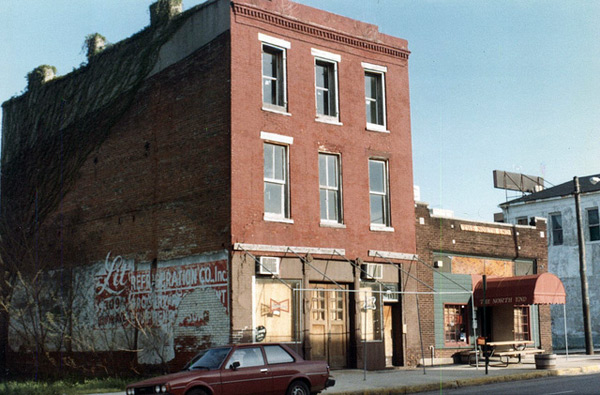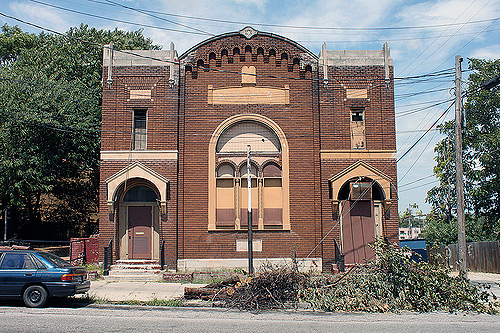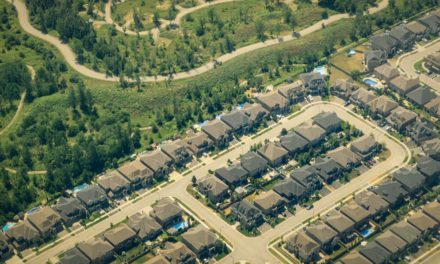The proposed moratorium on development in the Pinch Historic District may be 25 years too late, but it’s better late than never.
That’s why we think that Memphis City Councilman Berlin Boyd’s call for a moratorium is the right call at the right time. There’s no better cautionary tale for the need for a moratorium than what history should have already taught us: when the market is left to its own devices in the Pinch Historic District, the results can be devastating.
At the time that The Pyramid was under construction, the Pinch District had 43 historic and interesting buildings, and city and county governments believed that left to its own devices, the market would create new businesses, more jobs, and more vibrancy there.
Instead, the market created parking lots – lots of lots.
Paving Over History
The number of buildings in the meantime declined from 43 to 19 and fell to the point that Tennessee Historical Commission considered removing it from the National Register of Historic Places.
We know that the character of the Pinch District fundamentally changed because there was no master plan for it when The Pyramid opened and the intervening years have not been kind to it, but we the notion by the state historical commission that it should be removed from the list was short-sighted and indefensible.
Apparently, the public here sent the unmistakable message to the commission that the Pinch is near and dear to our community, and ultimately, the Historical Commission put the removal in an indefinite holding pattern.
We hope Councilman Boyd will stay strong with the moratorium idea, because much of the resistance seemed to stem from pique, self-interest, and turf protection rather than how best to protect, preserve, and improve the city’s historic Irish and Jewish neighborhood as an integral part of our Convention Center neighborhood.
Music To Our Ears
The purpose of the moratorium is straightforward: it preserves the status quo for a specified time until a land use and design strategy can be developed and adopted. It gives a city the chance to develop land use rules and hold any development in abeyance until it can respond to the new plan.
In Nashville, a moratorium on development is in effect for Music Row until mid-2016. It was the site of RCA’s famed Studio B, and frankly, there is no comparison to the historic significance and opportunities to redevelop Pinch Historic District into a blend of historic buildings with existing businesses that weathered the storm and with infill development that is historically appropriate for the area.
Seven years ago, Shelby County Government approved a moratorium for nine months for the unincorporated area as county government worked to come to grips with the financial implications of sprawl. It was too little too late, because the genie was already out of the bottle when it came to unsustainable land development.
Meanwhile, every month, cities and counties across the U.S. are passing moratoriums so that they can step back, take a breath, and be thoughtful about an important development opportunity. These are local governments who want to get the decision right, and we can’t think of a neighborhood in Memphis that deserves this more than the Pinch.
Getting It Right
With implementation of a moratorium, Memphis has the time to conduct a community process to consider the best future for Pinch District, including time to revisit ideas completed years ago by the Downtown Memphis Commission for six sub-districts, to consider whether the planning department’s special purpose district for the Pinch has any impact or whether there is as little commitment to special purpose districts as to overlay districts, and to consider a full plan of actions that can move the Pinch toward its potential.
To suggest that somehow the market will respond to opportunities in the Pinch District in an enlightened way is nothing short of magical thinking. It’s also wishful thinking, since if nothing else, the events when The Pyramid opened send a harsh lesson worth remembering. Instead of hoping that the right things are done, we need to determine what those right things are and align incentives and regulations to encourage and ensure that they happen.
Surely, no one is more interested in the Pinch District plans than its largest landowner: St. Jude Children’s Research Hospital. It has said in the past that it cares about the future of the neighborhood and about creating a positive front door and experiences for its patients and their families.
That said, we’re motivated to support a moratorium for the benefits for some of the small landowners, people who have withstood the decline of the Pinch District and soldiered on. These business owners deserve the opportunities for their property values to increase as the area becomes more successful with the implementation of a smart design and development plan.
A Mistake Out of the Box
Instead, the first idea out of the box showed how precipitous it can be for them. It was the proposal for a discount, extended-stay 108-room hotel more appropriate for Sycamore View than the Pinch District. It is precisely the wrong idea for the district and sets a low bar that could inspire similar ideas anchored in the lowest common denominator.
While it’s a wasted opportunity to get the rebirth of the Pinch off on the right foot, the discount hotel proposal also provides hotel rooms that have absolutely no positive impact on improving business at the Memphis Cook Convention Center. As Memphis Convention and Visitor Bureau Officials often emphasize, what Memphis lacks to be competitive are full-service hotel rooms, but in addition to not delivering this, it does nothing to improve the convention experience that convention goers say they want in the immediate neighborhood.
Put simply, because of City of Memphis’ ownership of the convention center and its $83 million investment in The Pyramid, it is appropriate, as recommended by Councilman Boyd, for the city to take the lead in ensuring that a smart master plan for the future of the Pinch District is developed.
It’s an opportunity we can’t afford to maximize. The opening of Bass Pro Shops at The Pyramid is delivering millions of people to the Convention Center District, which is the site of the downtown Tourism Development Zone, and already, more than 500,000 customers showed up in the first 27 days. The average Bass Pro Shops store attracts almost two million customers a year, and it’s obvious that The Pyramid will reach and exceed the average. Already, the number of customers and revenues are exceeding projections.
Something Special
With implementation of a design and land use plan, the Pinch this time could actually benefit from The Pyramid. Already, there is the plan to construct a pedestrian bridge to Bass Pro Shops (the previous bridge was not seismic or ADA compliant, but more to the point, it didn’t connect with an entrance into the building) and it and other public improvements should be located and determined within the context of the plan.
The really good news is that Bass Pro Shops is not only creating enough incremental sales taxes to pay for itself, but the TDZ will produce enough revenues to pay for infrastructure needed to upgrade the Pinch District in hopes of attracting a developer that can implement a plan that calls for working with the existing businesses to create something as special as the district was when Memphis was only a few decades old.
In Nashville, the moratorium was implemented to give the city time, with community input and a clearly defined process, to create a comprehensive design plan for Music Row. That seems a worthy goal that the Pinch Historic District deserves just as much.







In my view the Pinch district is already too far gone with too many parking lots and too many undistinguished old buildings that are falling apart. The Bass Pro Shop is a huge nightmare and just plain ugly. It does not fit the character of the neighborhood. St Jude should build clinics or offices in the lots they own. Sorry folks but downtown Memphis is a hot mess that won’t be improved much in this area because it’s already so far gone. Give it up because the Pinchbdistrict just doesn’t have much to offer except empty lots.
Then, what does it hurt to have a process to consider its scenarios for the future? People could have taken much the same attitude about South Main or Broad Avenue and look at them now.
I tend to agree about Bass Pro. We visited it and really it’s nothing more than a fancy big box sporting goods store. The surrounding area was desolate. Don’t really see how a self contained retail store is going to spill over to revitalize the pinch area. Bass Pro is like an island and not connected to the rest of downtown. Downtown Memohis overall is in bad need of more office workers if it’s ever going to improve.
And yet, Bass Pro has that effect everywhere else. We need to quit acting like somehow our problems are so great and our challenges so deep that the rules that apply to the rest of the country aren’t applicable here.
Then again, Howell and Jack G. are the same person, so we feel like we’re engaging in the conversation you’re having with yourself.
wish the naysayers would go ahead and move because i’m sick of their negativity while the rest of us are trying to make progress in this town.
I’m placing my bet that Howell, aka Jack G, is in a leadership position in an area municipality that has much to lose if the Memphis center city becomes fully competitive as she awakens from her slumber. But in all seriousness, of course the Pinch district is mostly empty lots. That’s the beauty of the area, as there is basically a blank canvas to create whatever the mind can imagine (within certain financial constraints).
🙂
Thanks for the logic, Chatul.
I agree that there should be a master plan for the Pinch District. However, we have had many years to develop one, and the city has done nothing. It is extremely shortsighted for us to reach this point before we realize that we don’t have direct access from Bass Pro to the Pinch or a master plan. Where is the leadership?
Good planning is good, but let’s zoom out. If we want to fight sprawl, we’re going to have to create attractive urban areas, preferably central urban areas. But the Pinch is on the edge of the metro region between downtown, which is almost an edge city and industrial, poor areas of North Memphis. So while marginal improvements to help the convention center, pyramid, and St. Jude make sense and to tidy up the area make sense, I’m not sure that the Pinch will ever be of primary strategic importance to smart growth in Memphis. My guess is that the market didn’t turn the Pinch around because few want to be next to uptown and downtown is slowly declining as the city moves east. I mean, my ancestors were Irish, but the Pinch is a rough area with zero sentimental value to me.
What I’m getting at is a broader frustration that while I share this blog’s critique of unsustainable growth, it feels like much “smart planning” in Memphis focuses on restoring areas outside the core 240 loop. Leaders try to build small areas like Peabody Place up(hill) to high standards at great cost, but at the same time, entire regions like Raleigh, Hickory Hill, and Popular Plaza through Oak Court Mall to Quince thin out and decline. That’s not to pit particular neighborhoods against each other but to ask how to best organize the entire city physically for all races without throwing so much at a downtown on the outskirts? How do we take time to get the whole city right?
Can you think of any thriving cities with thriving downtowns on their perimeter?
What I’ve heard is that there has been some recent interest in the area? Read in the paper that there is a buyer of the place next to (the now closed) T. J. Mulligans. what the pinch needs is people to become interested, financial help, and a connection bridge to bass pro. So much potential lies within the area. I would say as much as if not more then broad avenue. My two cents and knowledge.
TB: Some cities with thriving edge downtowns include Chicago, San Francisco, Cleveland (yes, Cleveland! Believe it or not!) Vancouver, and Toronto.
A plan is a framework for making decisions. Done properly, it produces a preferred vision for the neighborhood’s future that stakeholders can agree upon and work toward achieving. Such a vision is not fanciful. Rather, it is based on sound and proven principles that are likely to produce an economically successful outcome that also adds life and vibrancy to the city. A vibrant city draws visitors and talented residents, raising the economy for us all. Creating such a city is enlightened self-interest for its residents.
As explained by the developer’s representative, the design of the proposed extended-stay hotel would do nothing to enliven the streetscape, nor would it serve Bass Pro customers. Instead, it appears to be housing for senior citizens. What little retail it contains faces inward, accessible only to tenants in the hotel. It would provide no activity and vitality to help other Pinch merchants. That is why the Pinch could benefit from a vision that sets goals and guides decisions that will reach them.
A vision plan could and should involve participation by the area’s stakeholders; property owners, business owners, and institutions, as well as government. That conversation is beginning here, now. Let’s encourage it to continue.
The entire comprehensive planning staff at the OPD were to meet and discuss a Pinch District Master Plan. Sadly,one got sick and the other one didn’t want to meet by herself.
RB: I’m not anti-planning. I’m not anti-neighborhood-size-planning. I’m sure that the Pinch can be improved by people like you, and I strongly suspect that your thoughts on the extended-stay hotel are appropriate.
My point is that a thriving city is more important than a thriving downtown, which in turn is more important than a thriving neighborhood. The three are interrelated and mutually reinforcing, so the question I submit is how do we as citizens get the biggest bang for our money, political capital, and attention? How do we make sure that the Pinch isn’t built up at the expense of bigger and/or more influential areas? One approach to this question would be a plan for the whole city that sets priorities and creates an interrelated sense of proportion. That way seems to be the subject of a past posting that you wrote several years ago. Another approach would be to figure out the marginal cost of improvements and the marginal benefit of those improvements to various areas. Has anything like that been done in Memphis or for the Pinch? Why or why not?
As Chatul points out above, the beauty of the Pinch is that it’s a blank canvas. My untutored guess is that while an economic analysis wouldn’t prioritize upgrades to the Pinch, political feasibility might. Do you agree?
I’ve never been to Cleveland, but hasn’t that city lost hundreds of thousands of people post-2000? If indeed the downtown has thrived while the rest has decayed, why is that the case? What is the relationship between the two?